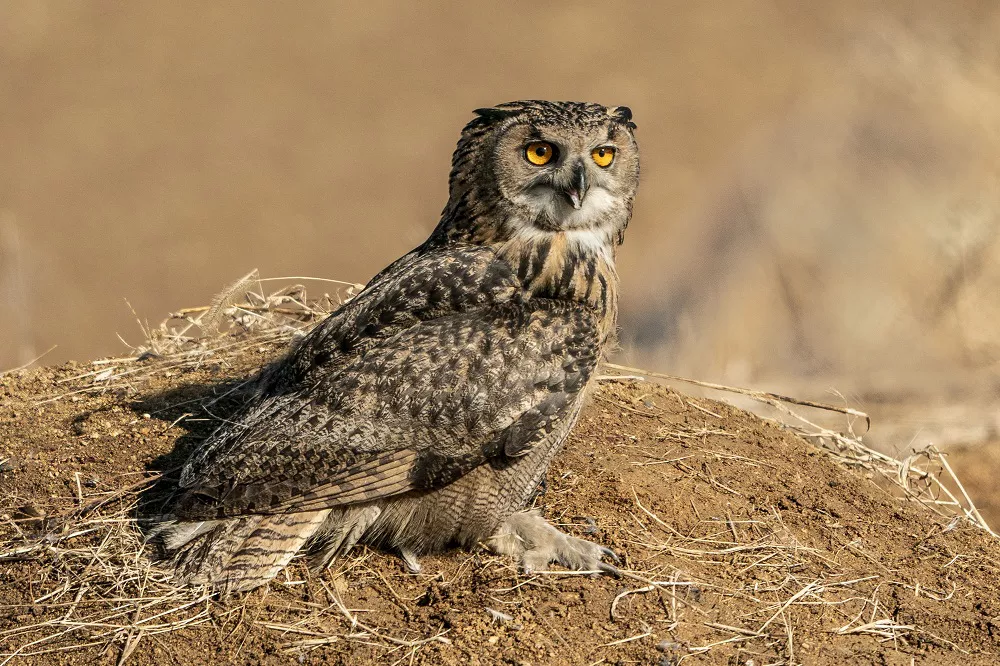The Eurasian Eagle-Owl (Bubo bubo) is a majestic and powerful owl species that commands attention with its imposing size and distinctive features. Renowned for its hooting calls and impressive hunting capabilities, this nocturnal bird has captured the fascination of ornithologists and bird enthusiasts around the world. In this article, we delve into the geographic distribution and preferred habitats of Eurasian Eagle-Owls, shedding light on the diverse landscapes they inhabit and the environmental factors that shape their range.
Geographic Distribution:
Eurasian Eagle-Owls are widely distributed across Eurasia, covering a vast expanse of territory. Their range extends from Europe and Scandinavia to Asia, including countries such as Russia, China, India, and the Middle East. Within this range, they inhabit a variety of ecosystems, demonstrating remarkable adaptability to diverse geographical and climatic conditions.
Habitat Preferences:
Eurasian Eagle-Owls display a preference for rugged, hilly, and mountainous terrain, including rocky cliffs, canyons, and forested areas. These habitats provide the owls with suitable nesting sites and vantage points for hunting. They have been observed in various habitat types, including coniferous forests, deciduous woodlands, steppes, open plains, and semi-arid regions.
Rocky Habitats:
Eurasian Eagle-Owls have a particular affinity for rocky habitats. They often select cliffs, rocky outcrops, and abandoned quarries as nesting sites, utilizing the natural crevices and ledges for shelter and protection. These locations offer the owls a commanding view of their surroundings, aiding in their hunting endeavors. Rocky habitats are also favorable for nesting due to their inaccessibility to ground-based predators.
Forests and Woodlands:
Eurasian Eagle-Owls are frequently found in forested areas, including both coniferous and deciduous woodlands. Within these habitats, they seek out large, old trees with hollow cavities or broken branches for nesting. Forested environments provide ample prey opportunities, as they are home to small mammals, birds, and even reptiles and amphibians, which constitute the primary diet of Eurasian Eagle-Owls.
Open Landscapes:
While the Eurasian Eagle-Owl exhibits a preference for rocky and forested habitats, it is also known to adapt to open landscapes such as steppes, grasslands, and agricultural fields. In these areas, the owls often perch on fence posts, utility poles, or low branches, using their keen vision and hearing to locate prey such as rodents and small birds.
Climate Influence:
Eurasian Eagle-Owls are highly adaptable when it comes to climate. They can be found in regions with diverse temperature ranges, from subarctic areas to arid desert regions. However, they are less common in areas with extreme climates, such as extremely cold or excessively hot environments. The availability of suitable food sources, nesting sites, and sheltered roosting locations greatly influences their habitat selection within a given climate zone.
Conservation Implications:
Preserving and protecting the diverse habitats favored by Eurasian Eagle-Owls is crucial for their long-term survival. Deforestation, habitat fragmentation, and human activities that disrupt their nesting sites can have detrimental effects on their populations. Conservation efforts should prioritize maintaining the integrity of rocky cliffs, forests, and other key habitats while promoting sustainable land use practices that support the owls’ prey base.
Conclusion:
The Eurasian Eagle-Owl showcases its adaptability by inhabiting an array of landscapes, spanning from rocky cliffs to forested regions and open plains. Understanding their habitat preferences and distribution is vital for effective conservation strategies aimed at preserving these magnificent birds. By safeguarding their preferred habitats and minimizing human-induced disturbances, we can contribute to the conservation of Eurasian Eagle-Owls and ensure the continued existence of these awe-inspiring creatures in the wild.
Related topics:


 Facebook
Facebook  Instagram
Instagram  Youtube
Youtube 